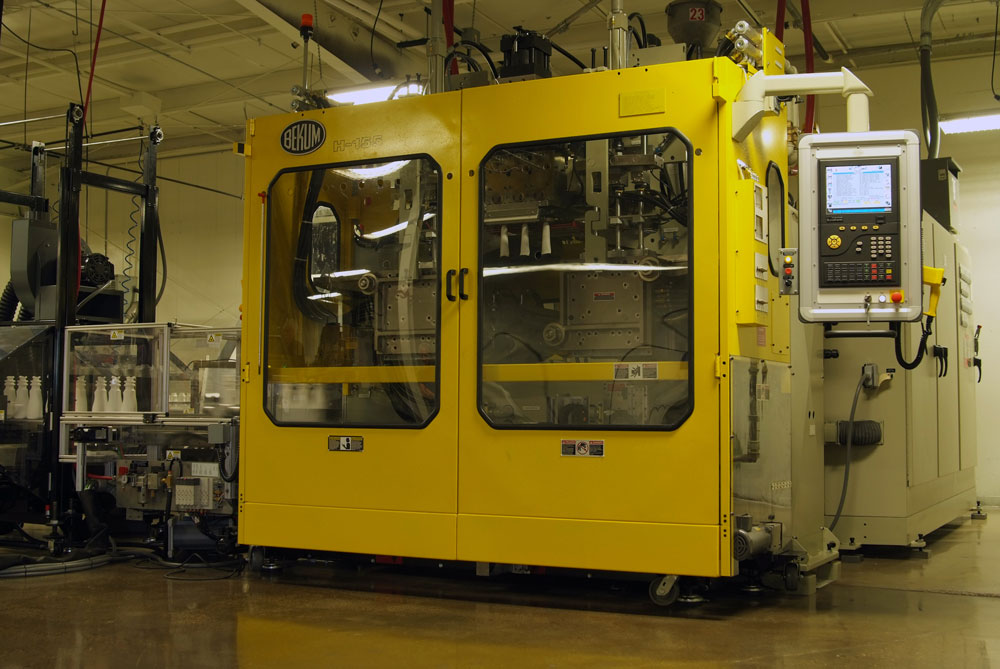By: Nick Hansen – Operations Manager
People often ask, What is Extrusion Blow Molding. Its a manufacturing process used for the production of plastic bottles, containers, and custom shapes. This manufacturing process can be accomplished through different methods, but at Apex Plastics we use extrusion blow molding (EBM) and injection stretch blow molding (ISBM). For this blog, we will focus on the EBM process.
The extrusion blow molding process can be broken down into two subcategories: continuous extrusion blow molding and intermittent extrusion blow molding. In continuous blow molding, the plastic is extruded constantly while the machine runs. With intermittent extrusion blow molding, the extruder runs for a designated amount of time and fills a reservoir with plastic; after the reservoir has been filled, a ram is activated and pushes the material from the reservoir through the extrusion head.
An EBM machine can be used to manufacture a wide variety of bottles, containers, and shapes commonly used to make products we use in daily life such as oil bottles, peroxide bottles, shampoo, and personal care items among many others. Intermittent EBM machines are often used to make large parts or products that require thick walls, such as 5-gallon water coolers and gasoline containers.
At Apex Plastics, we produce bottles, containers, and shapes from less than 2 ounces to over 1 gallon on continuous EBM machines. Materials processed in our EBM include high-density polyethylene (HDPE), low-density polyethylene (LDPE), and polypropylene (PP).
The continuous extrusion blow-molding process begins by loading the resin into a hopper on the top part of the machine, which is then fed into an extruder. The plastic can be processed in its natural state, or it can be blended with a wide variety of colors and additives. The material handling systems, composed of blenders, grinders, surge bins, and other components, are used to manage and move material within the facility. Material blenders provide consistent batches of material throughout the production process.
The extruder contains a screw that continuously turns, pushing the plastic resin down the barrel. Through mechanical friction, the plastic is transformed from a solid pellet form, into a molten state. Heaters strategically placed on the barrel and head help maintain a uniform heat during the extrusion process. The melt strength is important to maintain a uniform wall thickness to avoid holes in the final product. The molten plastic is then pushed through an extrusion head, and past the die tooling that forms the parison. The parison is a hollow tube of molten plastic that will become the final product. The extrusion head and die tooling determine the length and shape of the parisons. For heavy or large parts, a single extrusion head may be used allowing only one part to be made during each cycle of the machine. Smaller parts use extrusion heads capable of making multiple parisons at the same time. Making multiple parts at a time increases productivity time during a machine’s cycle.
The mold encloses around the parison, and then a blow pin enters the top of the parison sealing the tube. The pins compress air into the parison to mold the plastic into the final shape of the product. Molds are commonly made of aluminum or other metals. The mold is then cooled to facilitate the quick formation of the finished part. Once the plastic has cooled and hardened, the mold opens up and the final product is ejected.
After the part is ejected, excess plastic, or flash, is then removed manually or by machine. The flash is sent through a grinder where it is cut into small pieces and then transferred to a surge bin. The recycled material, or regrind as it is commonly called, can be reintroduced to the manufacturing process through the material handling system keeping waste to near zero.
Our EBM equipment includes three Bekum H-155 machines, installed new in 2012, 2014, & 2016. These machines can be configured from a single cavity to eight cavity production. They are also equipped with a bottle transfer MTM Systems unit. Our latest addition to the Bekum line up and capabilities, it the ability to produce bottles with view stripes. View stripes process involves a multi-cavity die head that produces parisons with a translucent view stripe made of a secondary, non-pigmented resin

Apex Plastics also offers one and two-cavity production on smaller Hayssen blow molding machines. These machines, in model 2125 & 2150, allow for mold stack heights of 8.5” to 10.25” in a variety of head spacings. These machines are perfect for custom bottles that do not require high production volumes.
In conclusion, the continuous extrusion blow molding process provides a lot of flexibility in the Blow molding manufacturing process. From resin variety to container sizes and machine processes, Apex Plastics can offer a wide variety of configurations to meet the customer’s needs. Whether you need 10,000 bottles or 1 million bottles, Apex Plastics is here to help you find solutions for your next project.
If you have any additional questions regarding the EBM process or would like to request a quote, please do not hesitate to contact us through our website www.apexplastics.com, or at 1-800-467-4640.
